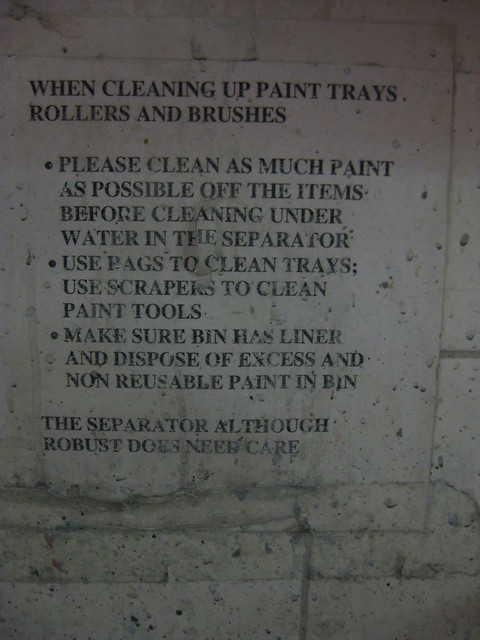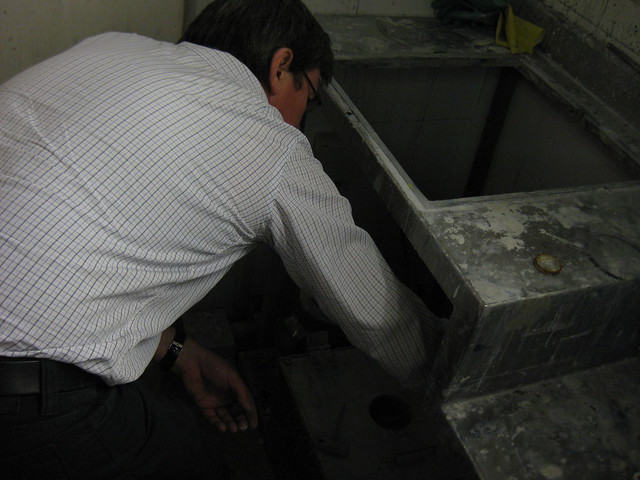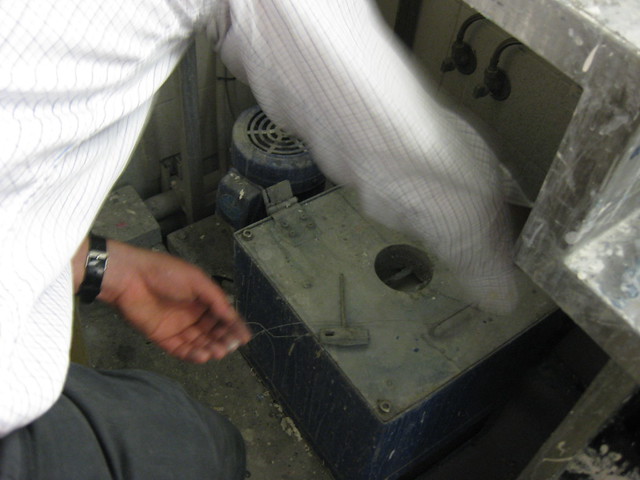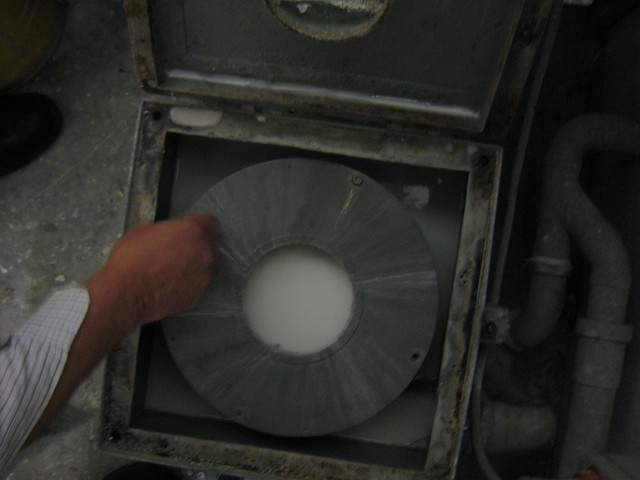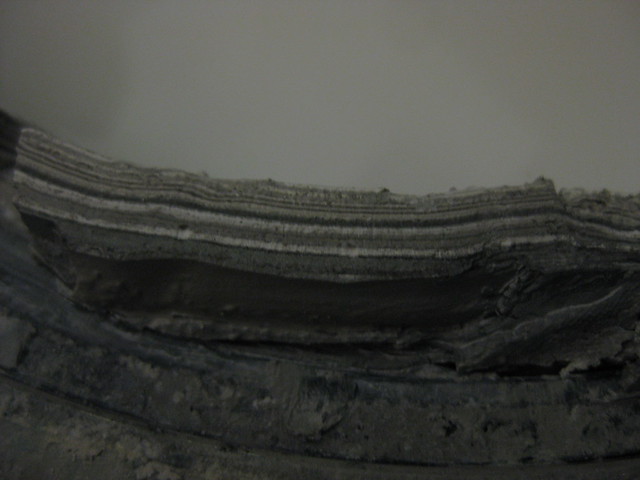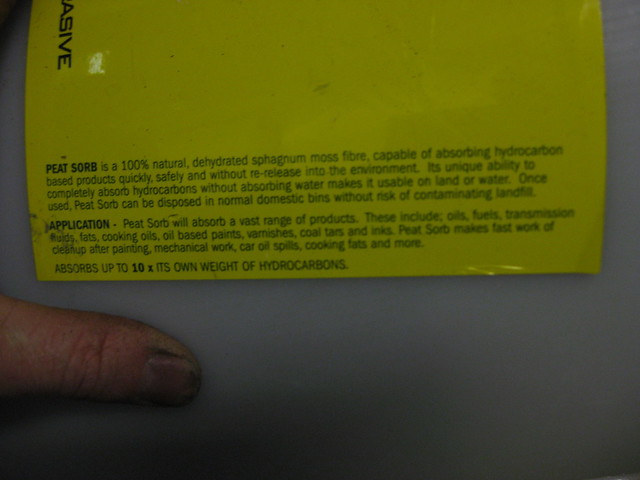Some folks who work at the MCA are taking this audit business very seriously. And good for them, I say!
Tony, who runs the exhibitions set-up department is one such enthusiast, who has grasped the nettle (and sometimes my lapels) quite firmly (he responded at length to my exploration of wall-building and other issues here).
After reading my series of rather minor exposés, Tony bailed me up outside the lifts one day and said: “What you’ve revealed is all a bit negative so far. I want to show you some good things! Like the paint separator…”
So a few days ago he took me on a small adventure to “The Paint Room” on level four, to find out about this paint separator business… “Take photos!” Tony commanded. (He wants the whole world to see this wondrous machine…)
OK, so here are some photos! First of all, we have Tony rummaging under the sink to access the paint separator (also notable is that Tony has a set of very nice shirts which he always tucks in and manages to keep neat, even while undertaking such mucky endeavours):
Basically, the issue here is that the MCA goes through a heckuva lot of paint every year. Every time a new wall is built, it’s painted white (or “snowdrift” or whatever euphemistic name the paint company comes up with).
Whenever there’s a video installation, the room is painted black or dark grey, then returned to white afterwards. It’d be a pretty safe bet to say that if you checked the original architectural interior fit-out plans from the early 1990s, the galleries in their current state would be somewhat smaller than they used to be, because of the hundreds of layers of paint slowly inching their way, one-by-one into the space… (Not to mention weight! With all that paint, the MCA must now weigh a great deal more than it used to!)
All this painting means lots of rollers and brushes need washing. Washing them means that paint ends up being flushed down the drain into the sewers, clogging up pipes and contaminating the wastewater system. So the trick is to separate out that paint before it gets down the drain.
How to do this?
Well, the paint separator is essentially a sort of “centrifuge“, which spins incredibly fast, forcing the paint particles in suspension to separate out from the water and stick to the side of the cylinder. (It’s a bit like how your clothes cling to the outside of the washing machine during the spin cycle.)
The water, thus freed of paint, is then able to run through a series of fine filters and down the drain.
It’s as simple as that!
Here’s what the separator looks like from the outside:
…and here ’tis with its lid off – you can see milky water in suspension, prior to having the paint separated out (it stinks of “old paint”: a smell Tony says he doesn’t mind, but other people can’t abide):
…and the next one is one of my favourite shots. You see all those thin stripes, like the growth rings of a tree? They are small deposited layers of paint which have been separated out from the water.
Tony says he comes down every so often and cleans them out – the built-up paint gets added to this peat-moss stuff which helps it further congeal, and then the whole thing can go into landfill.
Here’s the peat moss, it’s a strange and interesting organic material (actually it just feels like woodchips!):
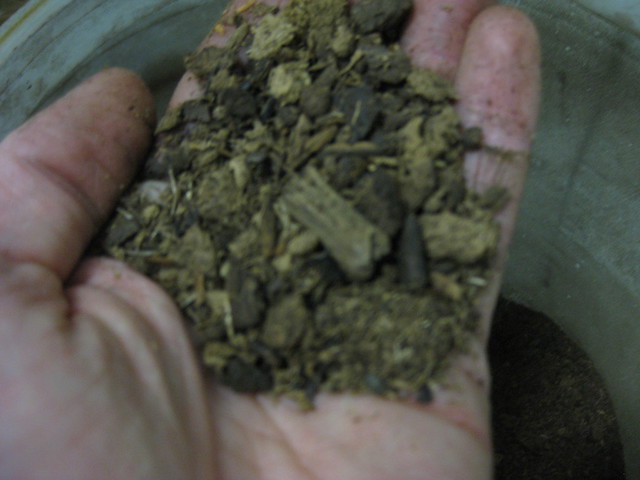
And that’s that! Of course, as Tony said, the paint (acrylic paint is some sort of vinyl or polyester) will then probably sit cheerfully in landfill for the next ten thousand years. But at least it will be more compact, and certainly more inert than if it was introduced into the waterways.
Which is, admittedly, exactly what happens whenever we “home handymen” wash out our brushes directly in the laundry sink, right?

UPDATE: Euan, the Chief Operating Officer just slapped me about in the office upstairs. “You forgot the most important part!” he said. “The MCA is one of the only museums in Australia (if not THE only museum) which has such a paint separator! We’re a model for responsible exhibition practices – you have to pass on that crucial message!”
Of course, Euan, how could this have slipped through? Consider it done.
(Incidentally, if anyone is reading this from another museum, be sure to let me know if you have such a machine – or perhaps some other system for taking care of paint waste – so I can bring Euan down to size).

Postscript: according to Tony, the Separator was installed by his predecessor, Marc, about 5 years ago. Tony reckons this was a very forward-looking, environmentally responsible initiative for its time – especially given that the machine cost about ten thousand dollars. Apparently there exists the threat of twenty thousand dollar fines for industrial contamination of the waterways if you get caught flushing paint down the sink, but he’s never heard of it actually being enforced…

